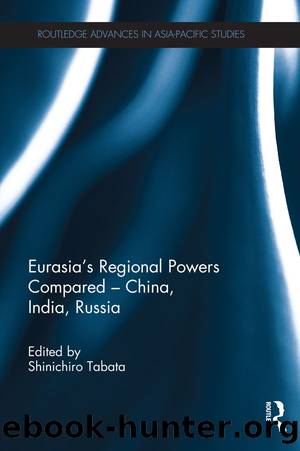Eurasia's Regional Powers Compared - China, India, Russia by Shinichiro Tabata

Author:Shinichiro Tabata [Tabata, Shinichiro]
Language: eng
Format: epub
ISBN: 9781138782945
Barnesnoble:
Publisher: Taylor & Francis
Published: 2015-01-08T00:00:00+00:00
Source: Radio Press (2011) China Directory, p. 552.
Despite these favorable developments, Gorbachevâs Soviet Union dissolved within two years after the end of the Cold War. Gorbachev faced three challenges after 1989. The first was domestic opposition to his rule. Perestroika legalized the voice of the opposition. In March 1990, the Soviet Congress decided to abolish the dictatorship of the CPSU, to introduce a multi-party system, and to allow private ownership of property. At the same Congress, Gorbachev made himself president of the Soviet Union, expecting to stay at the pinnacle of the federation. Soon, most of the Soviet republics set up their own presidents. Perestroika resulted in the âinflation of presidentsâ (Shiokawa, 2007a, p. 61). In June, Boris Yeltsin was elected as president of the Russian Republic. Popular elections made Gorbachev vulnerable because he had never been popularly elected.
The second challenge came from the Persian Gulf. The unfolding of Saddam Husseinâs Kuwait campaign showed that the Soviet Union could play only a minor role in the world of realpolitik. Gorbachev could not stop Saddam from engaging in a fatal invasion of Kuwait. Neither could he prevent George H. Bush and other Western leaders from initiating a war against Iraq. Gorbachev was busy keeping his own house together. While Dengâs China took advantage of the occasion and returned to the world community in 1990, Gorbachevâs Soviet Union made a diplomatic retreat. To make matters worse, Eduard Shevardnadze, Soviet foreign minister since 1985 and Gorbachevâs right-hand man, quit the government in December 1990. Gorbachev lost one of the most important assets of diplomacy: consistency.
The third challenge, the so-called federation issue, turned out to be a fatal blow to Gorbachev. According to Shiokawa, up until the end of 1989, Gorbachev succeeded in holding down the federal republicsâ demands for independence (Shiokawa, 2007a, p. 56). Gorbachevâs intention to tighten central control, however, suffered a serious setback in 1990. In some Soviet republics, non-communists won the majority in the popular elections for the supreme soviets. Some of them demanded outright independence. Some of them demanded greater self-rule. Three Baltic countries declared their independence in February and March. In June, Russia declared its own sovereignty. Georgia, Moldova, and Armenia soon followed. The successive declarations of sovereignty, the âparade of sovereigntyâ (Shiokawa, 2007a, p. 61), greatly increased the centrifugal force of departures from the Soviet orbit.
Recent studies have revealed that the dissolution of the Soviet Union was neither inevitable nor coincidental. Shiokawa Nobuaki, a Japanese researcher, argues that the dissolution was the result of human drama, which was played out by the major actors in the short period of NovemberâDecember 1991 (Shiokawa, 2007b, pp. 551â73). Kawato Akio, a former Japanese diplomat, concluded that the dissolution was the result of the political plot designed by Boris Yeltsin. Yeltsin succeeded in depriving his rival Gorbachev of his political base by dissolving the Soviet Union and banning the CPSU (Kawato, 2013, p. 134). Dmitri Trenin, a Russian researcher, contended that the Soviet Union had suffered a âsudden deathâ (Trenin, 2011, p.
Download
This site does not store any files on its server. We only index and link to content provided by other sites. Please contact the content providers to delete copyright contents if any and email us, we'll remove relevant links or contents immediately.
Chaco's Northern Prodigies : Salmon, Aztec, and the Ascendancy of the Middle San Juan Region after AD 1100 by Paul F. Reed(355)
Law Enforcement Interpersonal Communication and Conflict Management by Brian Douglas Fitch(347)
Digital International Relations by Unknown(346)
Critical Perspectives on Human Security : Rethinking Emancipation and Power in International Relations by David Chandler; Nik Hynek(329)
Skilled interpersonal communication: Research, theory and practice, Fifth edition by Owen Hargie(327)
The Enduring Color Line in U.S. Athletics by Krystal Beamon Chris M. Messer(325)
Evidence-Based Policy Making in Labor Economics by Hamermesh Daniel S.;Nottmeyer Olga K.;Nottmeyer Olga;King Sarah;King Sarah;King Sarah;(298)
EPSO CAST Political affairs EU policies: How to succeed in the selection procedure by Franco Reverte José María(290)
Writing Public Policy - A Practical Guide to Communicating in the Policy Making Process by Catherine F. Smith(272)
Criminological Theory in Context by John Martyn Chamberlain(270)
Tibeton Yoga Its Secret Doc by Evans-Wentz(267)
Threshold Concepts in Women's and Gender Studies by Christie Launius Holly Hassel(264)
Rothschild and Early Jewish Colonization in Palestine (Geographical Perspectives on the Human Past) by Ran Aaronsohn(264)
Positive Psychology and Spirituality in Counselling and Psychotherapy (Conflict, Ethics, and Spirituality, 12) by unknow(261)
Social Problems, Social Issues, Social Science by James Wright(260)
Play in child development and psychotherapy: toward empirically supported practice by Sandra W. Russ(254)
Cognitive Development in Infancy and Childhood (Elements in Child Development) by Mary Gauvain(252)
Latin American Politics and Society by Gerardo L. Munck & Juan Pablo Luna(224)
What Makes a Social Crisis?: The Societalization of Social Problems by Jeffrey C. Alexander(220)
